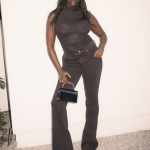Imagine struggling, treating, and living with a chronic condition that you can’t even pronounce. I’m kidding—sort of. I manage an inflammatory skin disease called hidradenitis suppurativa, commonly abbreviated as HS.
My condition is in the earliest stage, and I don’t think it’s very noticeable. That’s how I went years without a diagnosis—I didn’t really notice. I wish I knew what to look out for as someone who lives with mild HS.
Because I have polycystic ovary syndrome (PCOS), I’m accustomed to painful, cystic acne that shows up fast and furious on my cheeks and along my jaw. When I started to see the same type of bumps appear under my arms and breasts in the fall of 2020, I figured that was just part of the whole PCOS deal.
These inflamed red bumps were different, though. Similar to acne, they showed up either alone or in clusters. But compared to whiteheads, these felt harder in the center and were filled with pus. They also felt a lot more sore than a pimple. Over time, I experienced these types of bumps under both armpits, under both breasts, and along my groin. Still, I didn’t pay them much attention at first.
That changed when I went to urgent care in April 2022 for what I thought was an ingrown hair. I’d been experiencing soreness in my groin for about a week, attributing it to friction from a new pair of jeans. When it began to feel like a golf ball under my skin, I knew I had to seek professional help.
I was unprepared for the question the urgent care physicians asked me upon examination. “Have you ever had an abscess before?”
What? An abscess? Like an infection?
They numbed the area and incised and drained the bump right there on the exam table. I fought back tears; this hurt. I left the clinic with an open wound to manage and without any answers.
I felt ashamed. How did I let it get to this point? I didn’t know what was going on with my body and I was deeply frustrated.
Looking back, I didn’t anticipate the mental component of HS. I felt like the fact I was developing these bumps meant I lacked proper hygiene, even though I often showered twice a day.
For the most part, I was able to conceal my affected areas. But when summer and swimsuits were tough. I also felt anxious about wearing sleeveless outfits for modeling gigs.
These mystery bumps were starting to really impact my mental health, and I needed to figure out what to do.
Believe it or not, I had heard of hidradenitis suppurativa before. My job at the time required me to engage with people living with various chronic conditions regularly, but I didn’t think I could have HS. None of the clinical images I’d seen of this disease looked anything like what I was experiencing—they depicted large areas of inflamed and disfigured skin. I downplayed my experience because it didn’t compare to other people’s.
At my annual gynecological exam in summer 2022, I mentioned the groin abscess and how I sometimes developed similar bumps in my armpit. The physician assistant took a closer peek, noting it looked consistent with hidradenitis suppurativa.
While I certainly didn’t want to add another chronic condition to my body’s resume, putting a potential name to my issue felt extremely affirming. Someone else saw what I saw. I promptly followed up with a dermatologist.
It didn’t take my new dermatologist long to diagnose me with HS. Even though I didn’t have a major flare at the time of my appointment, she could still tell.
I felt liberated. I’d been managing at home with an over-the-counter antibiotic any time a bump formed. My dermatologist prescribed me a stronger, better option for me: an easy-to-apply clindamycin lotion.
Since I’ve been diagnosed, I’ve been doing my best to take matters into my own hands and work on preventative measures for flares. The most helpful thing I’ve done—second to seeing a board-certified physician—is tap into the HS community online to learn what works for other patients.
I can’t even begin to explain how helpful the HS patient community is. I read that products I already had at home, like Hibiclens and glycolic acid, could help prevent bumps. I learned that using a hairdryer in addition to towel-drying my body after a shower helps ensure my skin is as dry as possible, preventing the bacteria that fuel HS from thriving. I stopped wearing bras to give the areas under my breasts a break. I was more particular about how frequently I shaved and where.
All of these adjustments reduced the number of flares I experienced.
Now, I can manage flares on my own. I don’t need to visit my dermatologist outside of a regular checkup, and I typically don’t need medication beyond over-the-counter ointments. I have an HS “emergency kit” handy to tackle a bump as soon as it pops up. It includes essentials like antibacterial body wash for prevention and antibiotic ointments for treatment.
Now that I’m in control of my HS, I no longer blame myself for not recognizing my initial symptoms. I’m hopeful that my story will impact others who may have been in the same shoes I was not long ago and that they will feel empowered, too.





